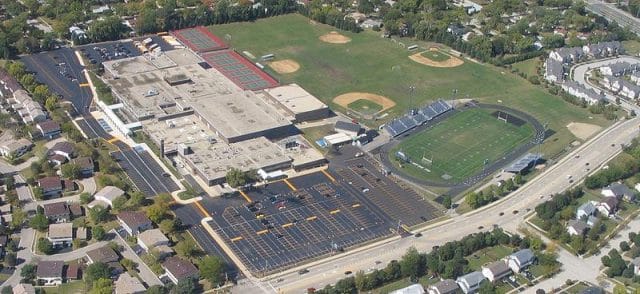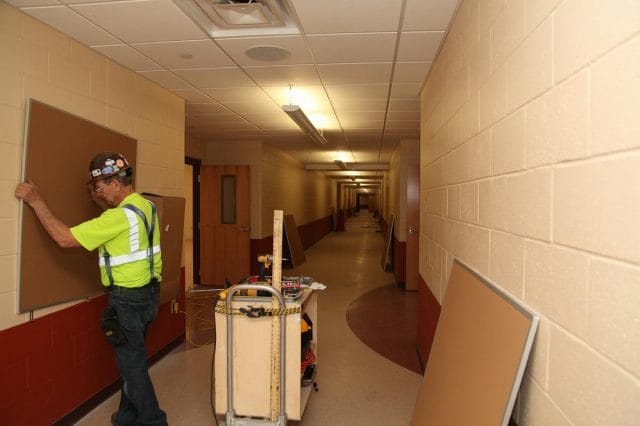Photo by Nauticashades
When Americans vote in the local school board elections every few years, they elect the individuals who oversee one of the country’s largest infrastructure projects: the construction and maintenance of America’s nearly 100,000 schools.
Any given school board member will be responsible for only a piece of that project. But, taken together, schools are the nation’s second largest public infrastructure investment after transportation. Roughly 55 million Americans (1 in 6) set foot in our public schools every day, according to the National Council on School Facilities, and they occupy an area equivalent to nearly 3,000 Empire State Buildings. There isn’t a public institution in the country that touches the lives of more Americans.
In other countries, provincial or national governments manage education systems, with varying levels of discretion for local officials. But in the United States, schools operate on the principle of local control, which means that the governing and management of public schools is done by locally-elected or appointed representatives such as school boards or school committees.
The United States is nearly unique in this respect, and when you think of schools as an infrastructure project, local control presents a unique problem: it’s inefficient and inequitable.
It’s inefficient because you’re asking every local school board in the country to borrow millions of dollars to construct or renovate school buildings. Inevitably, when a tiny school board works with financial firms to borrow money, they get fleeced. It’s inequitable because smaller school districts with less taxable wealth are hit with higher fees, which means that the poorest communities get the least out of their education dollars.
This is one of the unrecognized downsides of local control in America. We spend too much to get too little from school construction, paying billions to financial firms like investment banks and consultancies that could be spent on teacher salaries, technology for students, and specialized tutoring.
So you want to build a high school?
In countries like Canada, a central government authority oversees school facilities needs at the provincial level. Working with local school districts, they create a master plan for the province, and fund it through tax revenue collected at the national and provincial level. A few, smaller countries do this exclusively at the national level.
But the United States takes a rare approach: our school boards create their own plans and borrow money from investment banks, often by asking voters to approve bonds on the ballot.
A notable example of this process played out in 2010, in Colorado’s Adams County School District 1, otherwise known as Mapleton Public Schools. The district has about 8,500 students and 15 schools, and the school board wanted to build multiple new schools.

Photo by Fumo7887
First, Mapleton Public Schools committed to building new schools and financed it with a municipal bond, the primary mechanism for local school districts to fund multi-million dollar construction projects. They hired the financial advisory firm George K. Baum & Co. to manage the bond election process, which involved organizing pre-election efforts to get the bond approved by voters. George K. Baum & Co.’s motto is “Investment bankers since 1928.” The firm specializes in raising funds through debt for public institutions like schools, hospitals, and prisons, and its CEO got his start as a vice president at Salomon Brothers, the Wall Street investment bank that famously sold the first mortgage-backed security.
With the assistance of George K. Baum & Co., Mapleton’s school board won approval from voters in November 2010 to issue approximately $32 million in debt to match a state grant the district received for $22 million.
The Mapleton Public Schools received more state funding than is typical. On average, local districts contribute about 80% of the fiscal burden—through bond measures—for school construction projects, with the state typically chipping in the other 20%. The federal government has little to no role in the financing of such projects.

Graphic from The Center for Green Schools
After the vote, Mapleton Public Schools issued $9.67 million in bonds out of the $32 million that voters approved. They stayed in contract with George K. Baum & Co., and once the bond was passed, the Mapleton School District got its bond money and began building its schools.
For its services, Baum & Co. charged Mapleton Public Schools a fee of $43 per $1,000 of bonds issued, an approximate total of $415,000. The usual fee for school bonds is between $7 and $9 per $1,000 of bonds issued. That means that Mapleton seemingly overpaid by roughly $330,000.
Mapleton is not a unique case. An investigation by the Haas Institute at UC Berkeley found that annual issuance costs for municipal bonds nationally are between $3 billion and $4 billion. On average, this represents $1 of every $100 of funds raised.
One out of every hundred dollars may not seem extreme. But these costs fall disproportionately on poorer, rural school districts, and one percent of major infrastructure spending is serious cash. The amount spent each year by school districts on fees to investment banks and other financial firms (three to four billion dollars) is significantly greater than the amount New York decided to spend in 2014 to expand pre-K education across the state over the next five years ($1.5 billion).
In contrast, the majority of local school authorities outside of America receive regional or national funding for school construction and don’t give any local, taxpayer money to companies like Baum & Co.
So who are the firms that profit from issuing bonds for school districts? It’s a mix of Wall Street investment banks (who earn nearly 50% of issuance costs), law firms, insurers, ratings agencies, and consultants that support the bond issuance process. The buyers of that debt include firms like Nuveen Asset Management, Goldman Sachs Asset Management, and OppenheimerFunds, who, for example, recently bought $725 million worth of bonds from Chicago Public Schools at a whopping 8.5 percent yield.
Many districts have also gotten entangled in expensive debt financing deals, usually through capital appreciation bonds (CABs), which are longer term financing deals with significantly higher interest rates spread out over a greater number of years. CABS leave school districts saddled with exorbitant amounts of debt for many years. These CABs started popping up just after the financial collapse in 2009, when districts were finding it harder to get the funding they needed for school construction. The Newport Mesa Unified School District in Orange County issued $83 million in long-term notes in May 2011, but will ultimately pay about $548 million in principal and interest overall.
So why are our school districts—institutions that have been forced to cut teacher salaries, arts programs, and much more over the past decade—paying so dearly to build new schools?
School Financing: It’s Complicated
Investment banks charge districts like Mapleton such high rates to issue bonds for two main reasons: the small size of the bonds, and the fact that the firms help get voters to approve the bonds.
In the Mapleton case, this is one justification Baum & Co. gave for their high rates: they baked the cost of helping to get the bond approved by voters into the contract. Baum & Co. employees conducted voter research, developed informational materials for citizens, and crafted the language for the overall bond campaign. Many taxpayers might not realize (or would not appreciate) that their tax dollars pay consultants who convince them to support bond elections for school facilities rather than on direct services for students. But that’s how the system often works.
To add insult to injury, these firms benefit financially from the issuance of this debt (once it’s passed by voters) because they underwrite it as well. A recent study focused on California bond measures found that post-election fees paid to underwriters (like George K. Baum & Co.) that contributed to bond campaigns were on average double those paid to brokers that did not donate to campaigns.
As you might expect, this offers many opportunities for graft. In San Diego County, six underwriters (Stone & Youngberg, Piper Jaffray, UBS Securities LLC, Alta Vista Financial, RBC Capital Markets, and E.J. De La Rosa & Co.) hold sway over the entire local school construction market by using campaign donations to secure underwriting contracts.
But even after accounting for the cost of election services, school boards pay dearly to raise money for building or renovating schools due to a simple truth of the business world: the smaller and less experienced you are, the more you pay.
As a quick thought experiment, imagine if state governments managed school facilities. They could demand lower fees, and investment bankers would agree if they wanted to fund school construction anywhere in the state. Extending it a bit further, if the U.S. Department of Education handled school construction across the country, it would contract out so much money each year that firms would happily drive down costs in order to take a cut of a much larger pie.
In these hypothetical scenarios, we’d have experts negotiating for the best facilities, the efficiency of scale, and a stronger negotiating position for the central government to get the most out of our tax dollars.
Government agencies may not always run programs perfectly or with incredible efficiency. But the fact that Medicare negotiates with hospitals for some of the lowest rates in health care demonstrates that the scale of a federal program is powerful. No one would suggest that seniors would be better served by having officials in each county negotiate their health care prices instead.
With America’s schools, we can clearly see the inefficiency of local control at work. The Haas Institute for a Fair and Inclusive Society, a policy center at UC Berkeley, found that smaller districts in California sometimes pay $20 per $1,000 or more in underwriting fees (typical fees are usually half that). Dr. Marialena Rivera, Assistant Professor at Texas State University, has noted that “school districts turn to private entities, paying impressive sums, for financial expertise.” She stresses that the broader policy environment created by local control provides fertile ground for high fees.
We can also see the financial effect of local control in California. The California Policy Center has estimated that between now and 2055, California’s taxpayers will pay about $200 billion in principal and interest payments to investors who have bought bonds issued by the state and by local school districts for facility construction. Meanwhile, California is in the lower third of states when it comes to per-pupil spending.
The inefficiencies of local control are made worse by another uniquely American phenomenon: our sprawling suburbs. White flight—the mass exodus of white families to the suburbs in the post-war period—not only racially segregated students, it also spread students out, driving the need for more school construction. As James Howard Kunstler wrote in The End of Suburbia, “The project of suburbia is the greatest misallocation of resources in the history of the world.”
The poor combination of sprawl and local control can be seen in Maine. Between 1995 and 2005, statewide student enrollment dropped by 13,000. Yet the state still invested $790 million in school construction and renovation, adding five million square feet of school space. A study by the Office of School Facilities in Maine found that “as school populations decrease, the square footage per student increases; thus, the cost per student also increases.” Sprawl has wildly inflated school construction budgets, creating more small school districts that have to pay onerous fees to build facilities.
The inflated costs of funding schools wastes money, but a further problem is that those costs fall disproportionately on districts with lower property wealth, which also tend to be districts full of low-income families and communities of color. Moreover, local control perpetuates inequity as districts with lower local tax bases are often charged more in fees and financing just to engage in the process of securing a bond.
The inequities inherent in using local taxation to fund schools (more cash for rich districts, less for poor districts) become crystallized when we look at how local control plays out with school finances. It’s the difference between schools that only have a nurse on duty one day per week and whose art and music teachers have to commute between schools versus schools with small class sizes and fresh, healthy food.
When Regulation Isn’t Enough
Is this a problem that we can regulate our way out of?
State governments have already taken steps to prevent investment banks from walking away with too much taxpayer money. States like Missouri have banned companies from contributing to bond campaigns when they have a financial interest in the bond sale. In California, State Attorney General Kamala Harris has stated that districts should not allow financial firms to double dip by promising them underwriting contracts if they provide election services. Unfortunately, such opinions do not carry the force of law.
The municipal bond industry has also taken steps to regulate itself. In the rare instance mentioned above with Mapleton Public Schools, Baum & Co. was held to have violated the Municipal Securities Rulemaking Board’s (MSRB) Rule G-17 on fair dealing by charging a fee that was “inappropriate” and “disproportionate.” The firm agreed to pay a $100,000 fine and return $170,000 back to Mapleton School District in ill-gotten gains. MSRB is part of the Financial Industry Regulatory Authority, Inc.—a private corporation that acts as a self-regulatory organization.
Developments like these represent the Obamacare approach: trying to regulate the existing system and improve it through better oversight and restructuring of the market.

Photo by U.S. Army Corps of Engineers
But these regulations will all struggle, because they treat a symptom rather than the underlying problem. Outlawing “pay-to-play” practices and capping the amount that investment banks can charge to issue bonds will never achieve the lower costs that could be achieved at scale.
So why don’t we have the federal government manage the construction and maintenance of schools, cutting out the role and overhead of private financiers—the model used in most European countries?
The short answer is that although the United States Constitution does not explicitly mention education, the Tenth Amendment delegates powers not reserved for the federal government to the states. This means that states often take the lead on education policy.
While this makes a federally-led effort less likely, we could consider a regional approach. Nations like Canada have already made their funding process more efficient by consolidating school districts. Specifically, Ontario, as a province, has incentivized school district consolidation through a number of capital investments that will save millions in public funding for school construction in the long run.
Local control served the U.S. well when the young nation needed to expand its primary schools at a rapid pace across a large number of small communities. And many parents and politicians want to feel ownership over institutions as important to them as their local schools.
But as studies have shown the impact that physical environments have on student learning, it’s worth asking: What precisely are we getting for all of this money churn fueled by the peculiars of local control, and how might these funds going toward multiple intermediaries (investment banks, law firms, and consultancies) be better spent more directly on facilities that support learning?
Local control of schools is uniquely American. But perhaps, in this case, American Exceptionalism is making us less exceptional.
Our next article explores the complex mathematics of cutting cake. To get notified when we post it → join our email list.
![]()
Want to write for Priceonomics? We are looking for freelance contributors.






